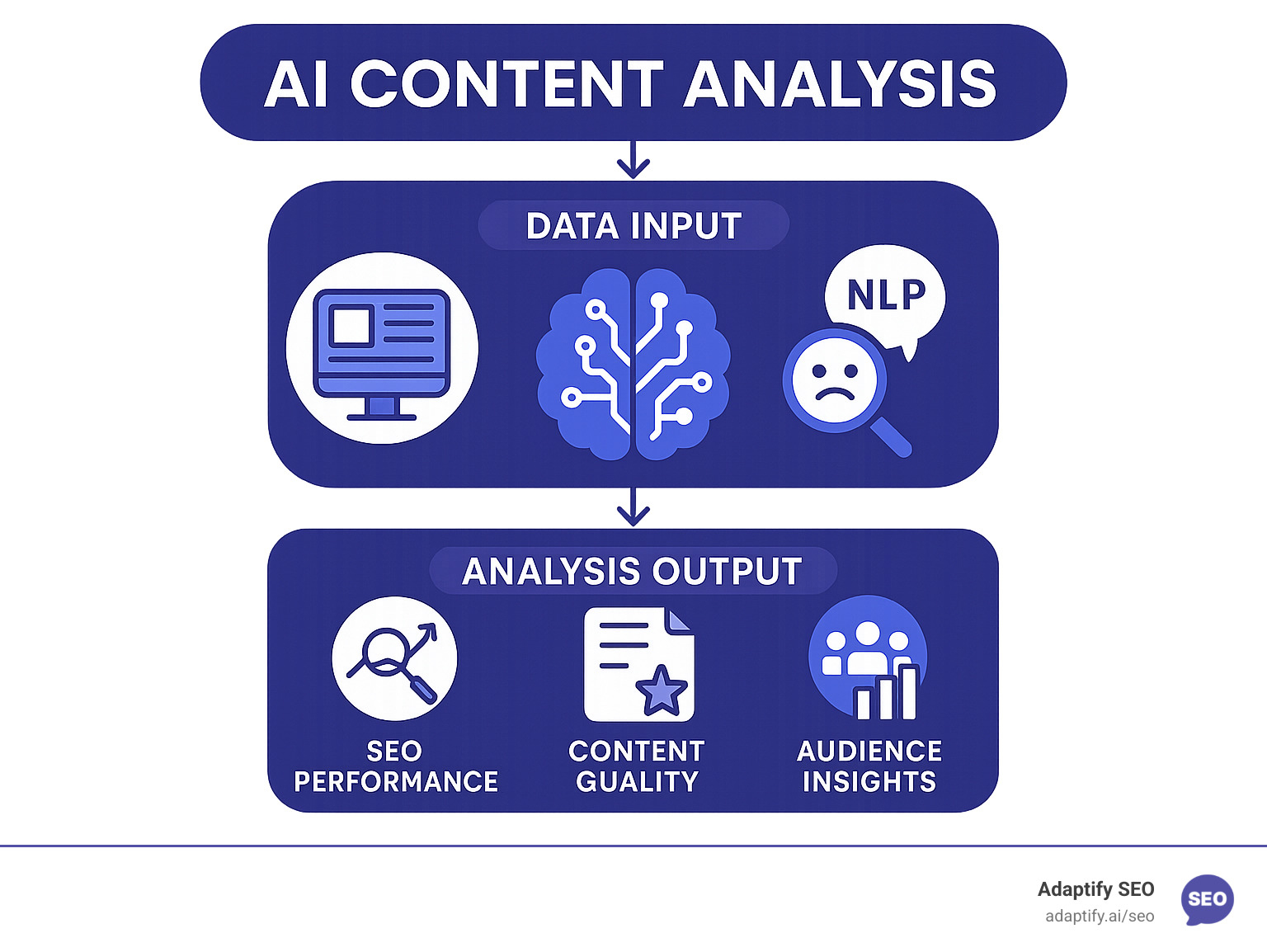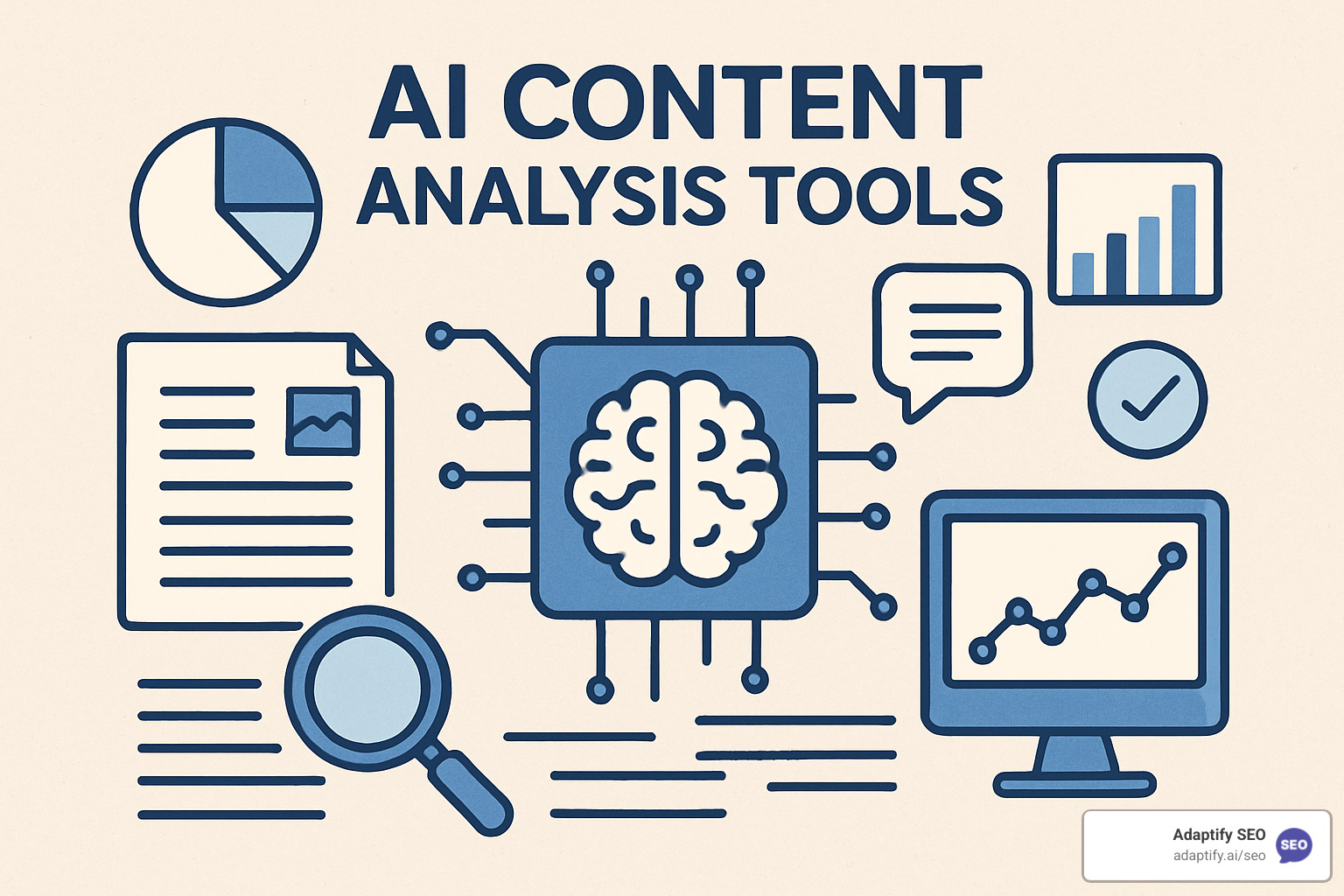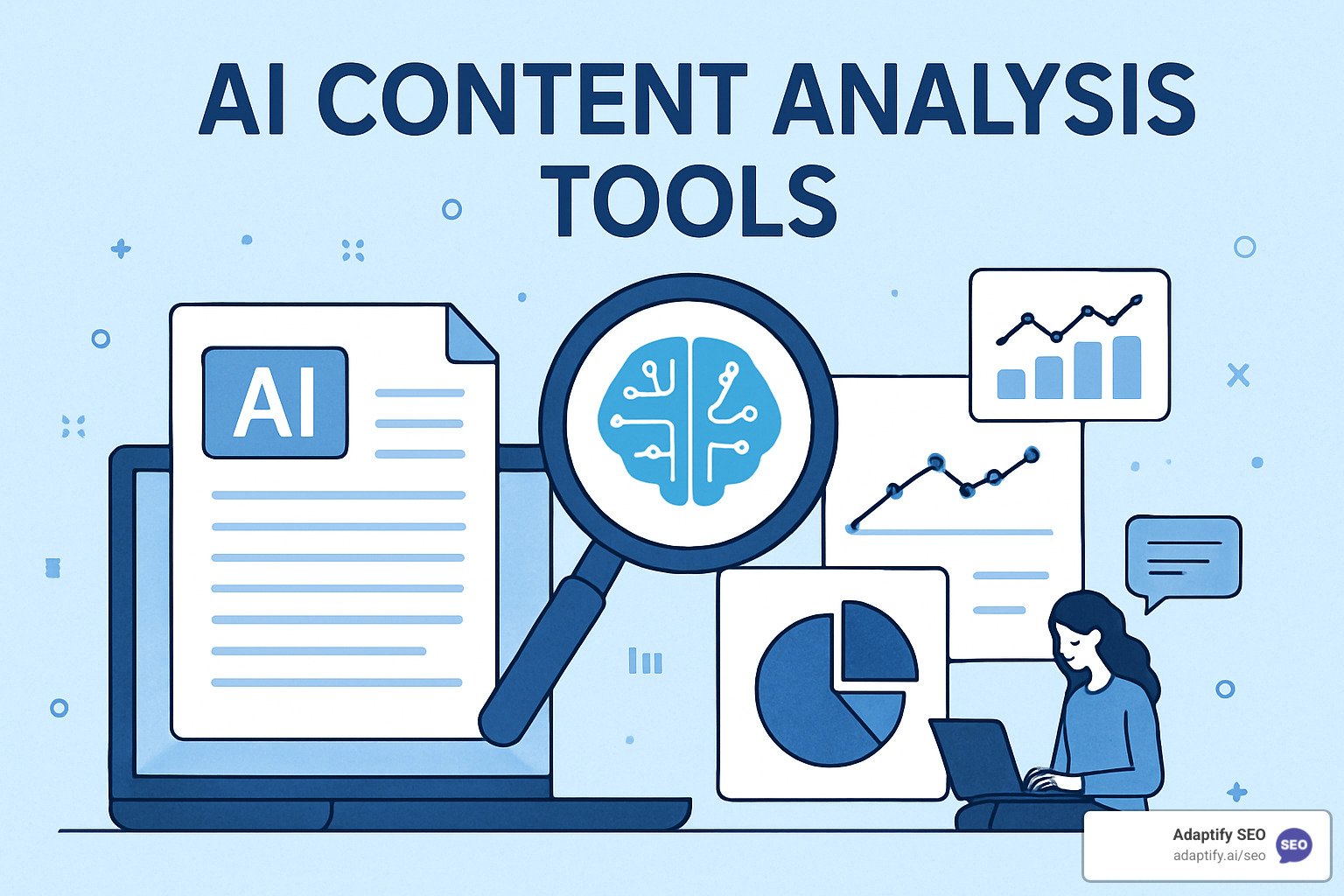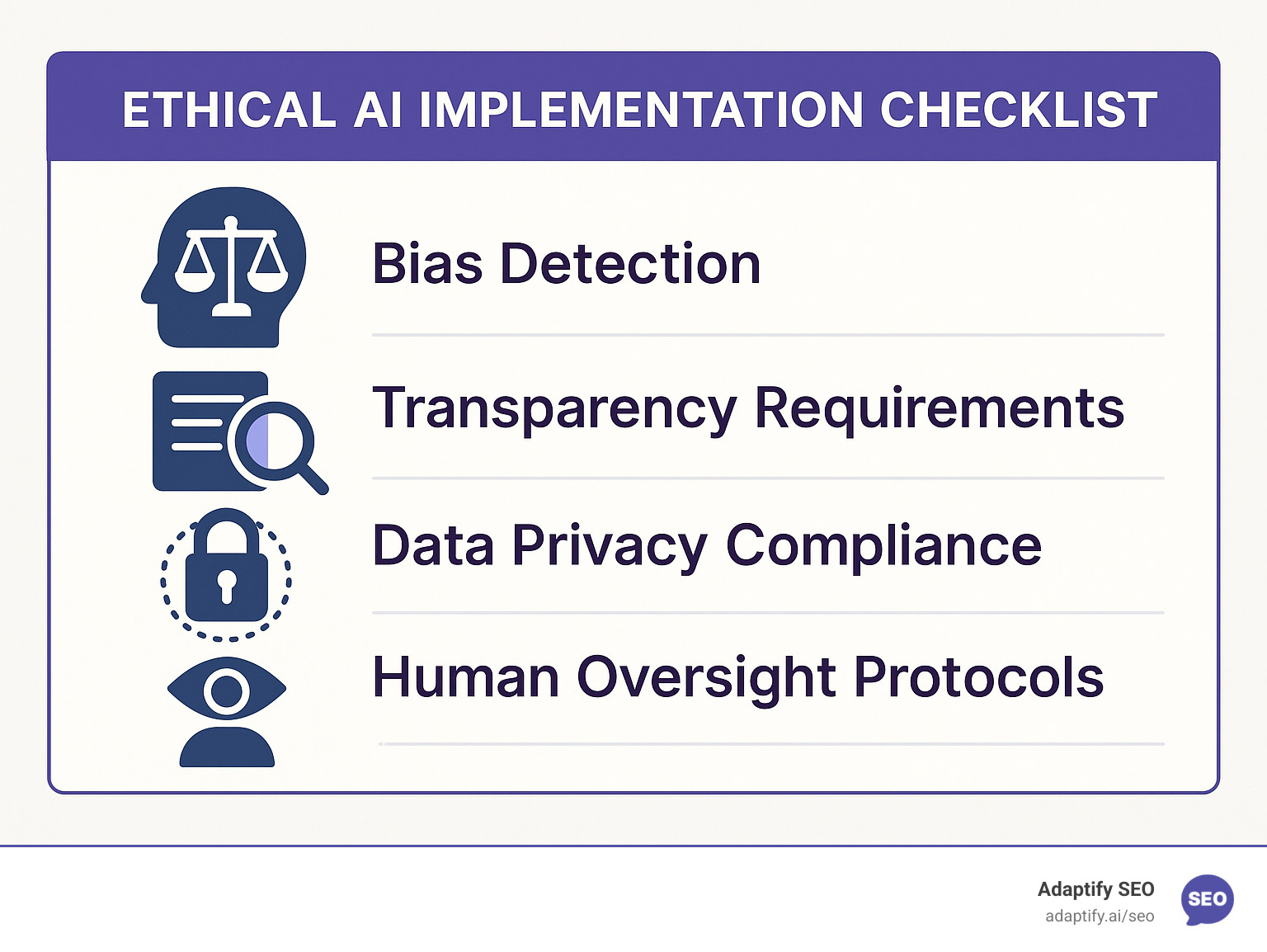Analyze This! Best AI Content Analysis Tools for Marketers
Hansjan Kamerling
Jun 20
Why Smart Marketers Are Switching to AI-Powered Content Analysis

AI content analysis tools are changing how marketers evaluate, optimize, and scale their content strategies. Instead of spending hours manually reviewing content performance and quality, these tools use artificial intelligence to analyze everything from SEO potential to readability in seconds.
Top AI Content Analysis Tools by Category:
- SEO Performance: Surfer, Clearscope, MarketMuse, BuzzSumo
- Quality & Readability: Grammarly, Hemingway App, Originality.ai
- Qualitative Research: NVivo, ATLAS.ti, Looppanel, Dovetail
- Free Options: Google Search Console, ChatGPT, Hemingway Editor
The numbers tell the story. More than 75% of marketers already use AI in some form for content marketing. Generative AI assistants can save professionals an estimated 200 hours of manual work per year, according to Thomson Reuters research.
But here's the challenge: not all AI content analysis tools are created equal. Some excel at SEO optimization while others focus on grammar and readability. Many promise everything but deliver mediocre results across the board.
The key is matching the right tool to your specific needs. Whether you're analyzing competitor content gaps, checking for AI-generated text, or extracting themes from customer feedback, there's likely a specialized tool that does it better than a general-purpose solution.

Why Modern Marketers Rely on AI
The shift from manual to automated content analysis isn't just about convenience—it's about survival in an increasingly competitive digital landscape. Traditional manual methods simply can't keep pace with the volume and complexity of modern content marketing.
Consider this: analyzing a single competitor's content strategy manually might take a full day. You'd need to review their top-performing pages, identify keyword patterns, assess content structure, and extract actionable insights. An AI tool can complete the same analysis in minutes while processing hundreds of pages simultaneously.
How Do AI Content Analysis Tools Work?
Ever wondered what happens behind the scenes when you upload content to an AI content analysis tool? It's actually pretty fascinating—and understanding the process can help you make better decisions about which tools to use.
Think of these tools as incredibly fast readers with perfect memory. They start by breaking down your content through something called tokenization—essentially chopping up your text into bite-sized pieces like words, phrases, and sentences that the AI can digest.
But here's where it gets interesting. Modern AI content analysis tools don't just count words like the old-school systems. They use Natural Language Processing (NLP) to actually understand what your content means. It's like having a colleague who can read thousands of pages in seconds and tell you exactly what each piece is about.
The real magic happens through several key processes working together. Sentiment analysis figures out whether your content feels positive, negative, or neutral to readers. Topic modeling identifies the main themes and subjects you're covering. Meanwhile, named entity recognition picks out specific details like company names, locations, and key people mentioned in your text.
Machine learning algorithms power all of this by learning from massive datasets of content that's already been analyzed. According to research on generative AI productivity, these systems can save professionals around 200 hours per year by handling tasks that would take forever to do manually.
Under the Hood of AI Content Analysis Tools
The sophisticated stuff happens through classification and clustering algorithms that work like incredibly smart filing systems. These systems have learned from millions of examples of high-performing content, so they can spot patterns that correlate with success metrics like higher rankings and better engagement.
Modern language models like BERT and RoBERTa have completely changed the game. Unlike older keyword-stuffing detectors, these models actually understand context and nuance. They can tell when you're being sarcastic, identify relationships between different concepts, and even detect whether content was written by AI or humans.
Clustering algorithms are particularly clever—they group similar content together automatically. This helps you spot gaps in your content strategy. For example, they might reveal that your competitors are successfully targeting a whole cluster of related keywords that you've completely missed.
AI Content Analysis Tools vs. Manual Methods
Let's be honest—there's no contest when it comes to speed. While you're still reading the first paragraph of a competitor's blog post, AI tools have already analyzed their entire website and generated a comprehensive report.
But speed isn't the only advantage. Scalability is where these tools really shine. You can analyze hundreds of pieces of content simultaneously without breaking a sweat. Plus, AI systems maintain consistent analytical standards whether they're processing 10 articles or 10,000.
The consistency factor is huge. We all have good days and bad days, and our personal biases inevitably creep into our analysis. AI tools don't get tired, don't have Monday morning blues, and don't let personal preferences cloud their judgment.
However—and this is important—human oversight remains absolutely crucial. AI excels at pattern recognition and data crunching, but it can completely miss cultural nuances, strategic context, and creative opportunities that experienced marketers spot instinctively. The sweet spot is combining AI efficiency with human insight and creativity.
Top AI Content Analysis Tools for SEO Performance

When it comes to SEO performance, not all AI content analysis tools are built the same. Some crunch SERP data like mathematical wizards, while others focus on keyword clustering and competitive gap analysis. The best ones help you understand not just what's ranking, but why it's ranking—and more importantly, how you can outrank it.
Surfer SEO
Surfer SEO delivers serious value starting at just $29 per month. What makes Surfer special isn't just its price point—it's how the platform thinks about SEO analysis. Instead of throwing generic metrics at you, it digs deep into the actual pages ranking for your target keywords.
The platform creates detailed content briefs by analyzing the top 20 ranking pages for your target keywords. This brief includes keyword recommendations, content structure suggestions, and topical coverage requirements.
Surfer really shines with personalized difficulty scoring. Most tools tell you how hard a keyword is to rank for in general. Surfer analyzes your specific domain authority and existing content to show you which keywords are easiest for you to rank for.
The content scoring system gives you a real-time grade as you write, tracking everything from keyword density to content structure. You'll know before you hit publish whether your content has a fighting chance in the SERPs.
Google Search Console & Analytics
Sometimes the best AI content analysis tools are the free ones sitting right under your nose. Google Search Console and Analytics might not have fancy AI badges, but they're powered by the same machine learning systems that run Google's search algorithm.
Search Console reveals the brutal truth about your content performance. It shows you exactly which queries trigger your content, how often people see it in search results, and—most importantly—how often they actually click through.
The real goldmine lies in pages ranking between positions 11-20. These are your quick-win opportunities—content that Google already recognizes as relevant but needs a little optimization push to break into the top 10.
Other Notable SEO Tools
Clearscope takes a more academic approach to content optimization, assigning letter grades to your content and focusing on content readability and topical comprehensiveness. It doesn't just tell you to stuff more keywords—it analyzes semantic relationships between concepts.
MarketMuse operates differently by analyzing your entire content library to identify opportunities for building topical authority. Its competitive gap analysis shows exactly which topics your competitors are covering that you're missing.
BuzzSumo approaches content analysis from a social and viral perspective, excelling at trend spotting and backlink opportunity identification. You can analyze which content formats generate the most engagement and what types of headlines drive shares.
Best AI Content Analysis Tools for Quality & Readability
Creating content that ranks well is just the first step. The real challenge is making sure people actually want to read it. The best AI content analysis tools for quality and readability focus on the human side of content—clarity, engagement, and authenticity.
Grammarly & Hemingway App
Grammarly has evolved far beyond simple spell-checking into something much more sophisticated. The platform's tone analysis feature can detect whether your writing sounds confident, friendly, or overly formal—then suggest adjustments based on your target audience.
Grammarly's color-coding system makes prioritizing edits straightforward. Red highlights indicate grammar errors that need immediate attention. Blue suggestions focus on clarity improvements. Green recommendations target engagement, helping your content connect better with readers.
The Hemingway App takes a different approach, acting like a tough but fair writing coach. It highlights sentences that are too complex, flags passive voice, and calls out unnecessary adverbs that weaken your writing.
What makes Hemingway special is its focus on readability scores. The app assigns a grade level to your content, helping ensure you're writing at the right level for your audience. Most web content performs best at a grade 8 level or lower.
Originality.ai & Copyscape
The rise of AI-generated content has created a new challenge: proving authenticity. Originality.ai addresses this with claims of over 99% accuracy in detecting AI-generated text.
The platform offers different detection models for various use cases. Beyond AI detection, it combines plagiarism checking, fact verification, and readability analysis into a single platform.
Copyscape Premium remains the gold standard for plagiarism detection, offering batch checking for just a few cents per scan. While it doesn't focus on AI detection, it's still crucial for verifying content originality.
Other Quality Tools
Rockee takes a refreshingly human approach by embedding feedback widgets directly on your content pages, collecting real user perceptions and ratings. This real user feedback provides insights that no algorithm can match.
CoSchedule Headline Studio has earned the trust of more than 1 million marketers by analyzing headlines for emotional impact, clarity, and SEO potential. Strong headlines can dramatically improve content performance.
AI Tools for Qualitative & Thematic Analysis

When you need to make sense of hundreds of customer interviews, survey responses, or social media comments, AI content analysis tools for qualitative research become absolute lifesavers. These platforms can spot patterns and themes in massive datasets that would take human researchers weeks to identify manually.
Enterprise Research Tools
NVivo and ATLAS.ti have been the workhorses of professional qualitative research for decades. Now they're getting serious AI upgrades that make them even more powerful for content analysis.
ATLAS.ti's AI Assist feature feels like having a research assistant who never gets tired. You can literally chat with your data, asking questions like "What are the main themes in customer complaints?" and get instant, well-sourced answers.
What sets these enterprise tools apart is their commitment to analytical rigor. They maintain detailed audit trails and provide inter-coder reliability measures that academic researchers and professional analysts require.
Specialized UX Research Platforms
For UX researchers and product teams who need faster turnaround times, Looppanel and Dovetail offer more streamlined approaches to thematic analysis. Recent research shows that 77.1% of UX researchers now use AI in their projects.
Looppanel has earned a stellar 4.8-star rating on G2 by focusing specifically on user research workflows. The platform handles the tedious parts of thematic analysis automatically while preserving the flexibility that experienced researchers need.
Dovetail serves as a comprehensive research repository with built-in AI analysis. It automatically transcribes interview recordings, extracts key themes, and generates executive summaries—all without requiring multiple tools.
Both platforms emphasize something crucial: AI content analysis tools work best when they amplify human insight rather than replace it. The AI can identify patterns and suggest themes, but experienced researchers still need to interpret what those patterns mean for business strategy.
Choosing the Right AI Content Analysis Tool
Finding the perfect AI content analysis tool doesn't have to be complicated. The secret is being honest about what you actually need versus what sounds impressive in marketing copy.
Start with your biggest pain point and work from there. If you're drowning in competitor research, focus on SEO-focused tools. If content quality keeps you up at night, prioritize grammar and readability tools. Need to make sense of customer feedback? Look at qualitative analysis platforms.
Budget plays a huge role here too. You don't need to break the bank to get started. Google Search Console is free and incredibly powerful for SEO analysis. The Hemingway App costs just $19.99 once, and ChatGPT can handle basic content analysis tasks for most small teams.
Key Features Checklist
The features that matter most depend on how your team actually works. Automation depth should be your first consideration—some tools promise AI magic but still require hours of manual setup and tweaking.
Collaboration features become crucial as your team grows. Can multiple people review content simultaneously? Are there approval workflows that match how your team operates?
API access might seem like a technical detail, but it's essential for larger organizations. If you're managing content across multiple platforms, you'll want tools that integrate with your existing systems.
Multilingual support varies dramatically between platforms. Many claim to support 30+ languages, but accuracy can be hit-or-miss for anything beyond English.
Data privacy and ethics have become non-negotiable considerations. Choose tools with transparent data handling policies and bias mitigation features.
Implementing AI Content Analysis Tools in Your Workflow
Successfully adopting AI content analysis tools requires more than just purchasing software. It involves change management, team training, and establishing new processes that balance automation with human expertise.
The biggest mistake teams make is jumping in headfirst without a plan. They buy expensive tools, expect immediate results, and get frustrated when their workflow becomes more complicated instead of simpler.

The key is remembering that AI content analysis tools are meant to improve human creativity, not replace it. Your team's expertise becomes more valuable when amplified by AI, not less valuable.
Step-by-Step Adoption Roadmap
Define Clear Goals before you spend a penny. Are you trying to improve SEO rankings? Reduce content production time? Better understand customer sentiment?
Start with a Pilot Program rather than overhauling everything at once. Pick one content type or one team member to test your chosen tools. This approach lets you learn the tools and refine your processes before scaling up.
Train Your Team properly from day one. Your team needs to understand not just how to use the tools, but how to interpret AI insights and maintain quality standards.
Establish Human Oversight Protocols because AI tools, while powerful, aren't perfect. Create review processes that ensure human judgment remains central to your content strategy.
Monitor and Measure ROI consistently to justify your investment and identify improvement opportunities. Track time saved per content piece, improvements in search rankings, and overall team productivity.
The ethical considerations matter more than ever. Obtain proper consent when analyzing user-generated content. Regularly audit AI outputs for bias or inaccuracies. Maintain transparency about AI usage in your content processes.
Frequently Asked Questions about AI Content Analysis Tools
How accurate are AI content analysis tools?
The accuracy of AI content analysis tools depends heavily on what you're asking them to do. Think of it like having different specialists on your team—each one excels at their particular skill.
For basic tasks like sentiment analysis and theme extraction, most modern tools hit the sweet spot with 85-95% accuracy. That's pretty impressive when you consider they're processing thousands of pieces of content in the time it would take you to read just one.
SEO-focused tools like Clearscope and Surfer have proven their worth through results. When content creators follow their recommendations, they consistently see ranking improvements. The correlation between tool suggestions and actual search performance is strong enough that many agencies now consider these tools essential.
AI detection tools tell a more complicated story. Accuracy ranges wildly from 63% to 99% depending on which platform you choose and what type of content you're analyzing. Some tools excel at detecting ChatGPT-generated content but struggle with other AI models. Others work great for blog posts but miss the mark on technical writing.
Here's the reality check: AI tools are fantastic at spotting patterns and crunching data, but they can miss cultural nuances and context that seem obvious to humans. The most successful teams use AI for the heavy lifting, then apply human judgment for the strategic decisions that really matter.
What content types can these tools handle?
Modern AI content analysis tools have become surprisingly versatile. Gone are the days when you could only analyze plain text documents.
Text content remains the bread and butter—articles, blog posts, social media updates, emails, and even complex legal documents. These tools can tear through your entire content library and identify patterns you never knew existed.
Audio analysis has gotten remarkably sophisticated. Tools can now transcribe podcast episodes, analyze customer service calls for sentiment, and extract key themes from interview recordings. Some platforms even detect emotional tone from voice patterns.
Video content analysis happens through automated transcription, but it's getting smarter. Tools can now analyze both spoken content and on-screen text, giving you insights into your video marketing performance.
Image analysis might surprise you. OCR technology lets these tools read text within images, analyze infographics, and even interpret charts and diagrams. It's particularly useful for social media content analysis.
Structured data from surveys, forms, and databases flows easily into most analysis platforms. This makes it simple to combine quantitative survey data with qualitative feedback comments.
The real magic happens with cross-modal analysis. Advanced platforms can combine insights from text, audio, and visual content to give you a complete picture of your content performance. It's like having a research team that never sleeps.
Are there free AI content analysis tools worth trying?
Absolutely, and some of them are surprisingly powerful. You don't need to break the budget to start benefiting from AI content analysis.
Google Search Console and Analytics top the list of free tools that deliver real value. These platforms provide the foundation for understanding how your content performs in search results and with actual users. The insights you'll get about click-through rates, impressions, and user behavior are worth thousands of dollars if you had to pay for equivalent data elsewhere.
ChatGPT has become a secret weapon for quick content analysis tasks. While it's not as sophisticated as dedicated tools, it can summarize long documents, analyze sentiment, and extract key themes faster than most humans. The trick is knowing how to ask the right questions.
Hemingway Editor's web version offers excellent readability analysis without costing a penny. It highlights complex sentences and suggests improvements that can make your content more engaging. The insights are immediate and actionable.
MyMap.AI provides free AI content analysis with visual summaries that help you understand complex content at a glance. Usage limits apply, but it's generous enough for small teams to get real value.
Many premium tools offer free tiers that are surprisingly capable. Grammarly's free version catches most grammar issues and provides basic tone suggestions. Originality.ai gives you a few free AI detection scans each month. Various SEO platforms offer limited free analysis that can help you understand their value before committing to paid plans.
The key is starting with free tools to understand what AI content analysis can do for your workflow, then upgrading to paid options as your needs grow. Many successful content teams built their entire strategy around free tools before scaling up.
Conclusion
The world of AI content analysis tools has opened up incredible possibilities for marketers who want to work smarter, not harder. Whether you're trying to climb search rankings, improve content quality, or extract insights from customer feedback, there's likely an AI tool that can help you get there faster.
The beauty of these tools isn't that they replace human creativity—it's that they free you up to focus on what humans do best. While AI handles the heavy lifting of data analysis and pattern recognition, you can spend your time on strategy, storytelling, and building genuine connections with your audience.
Starting your AI journey doesn't require a massive budget or complete workflow overhaul. Begin with the free tools that Google provides, experiment with ChatGPT for basic analysis tasks, and gradually add specialized tools as you find what works for your team. The 200-hour annual time savings that research shows is just the beginning—the real magic happens when you use those extra hours to create better content and stronger strategies.
The most successful teams treat AI as a powerful assistant rather than a replacement for human judgment. The tools handle the tedious analysis work, but humans still make the strategic decisions that drive real business results.
The landscape will keep evolving, with new tools launching regularly and existing platforms adding more sophisticated features. But the core principle remains the same: AI content analysis tools work best when they're integrated thoughtfully into workflows that balance automation with human expertise.
At Adaptify SEO, we've seen how transformative the right combination of AI tools can be for agencies and marketing teams. Our automated SEO services bring together many of these analysis capabilities into streamlined workflows that reduce manual effort while improving results.
Ready to see how AI can transform your content strategy? Book a Demo to find how Adaptify SEO can help you implement these tools effectively and start seeing measurable improvements in your content performance.
